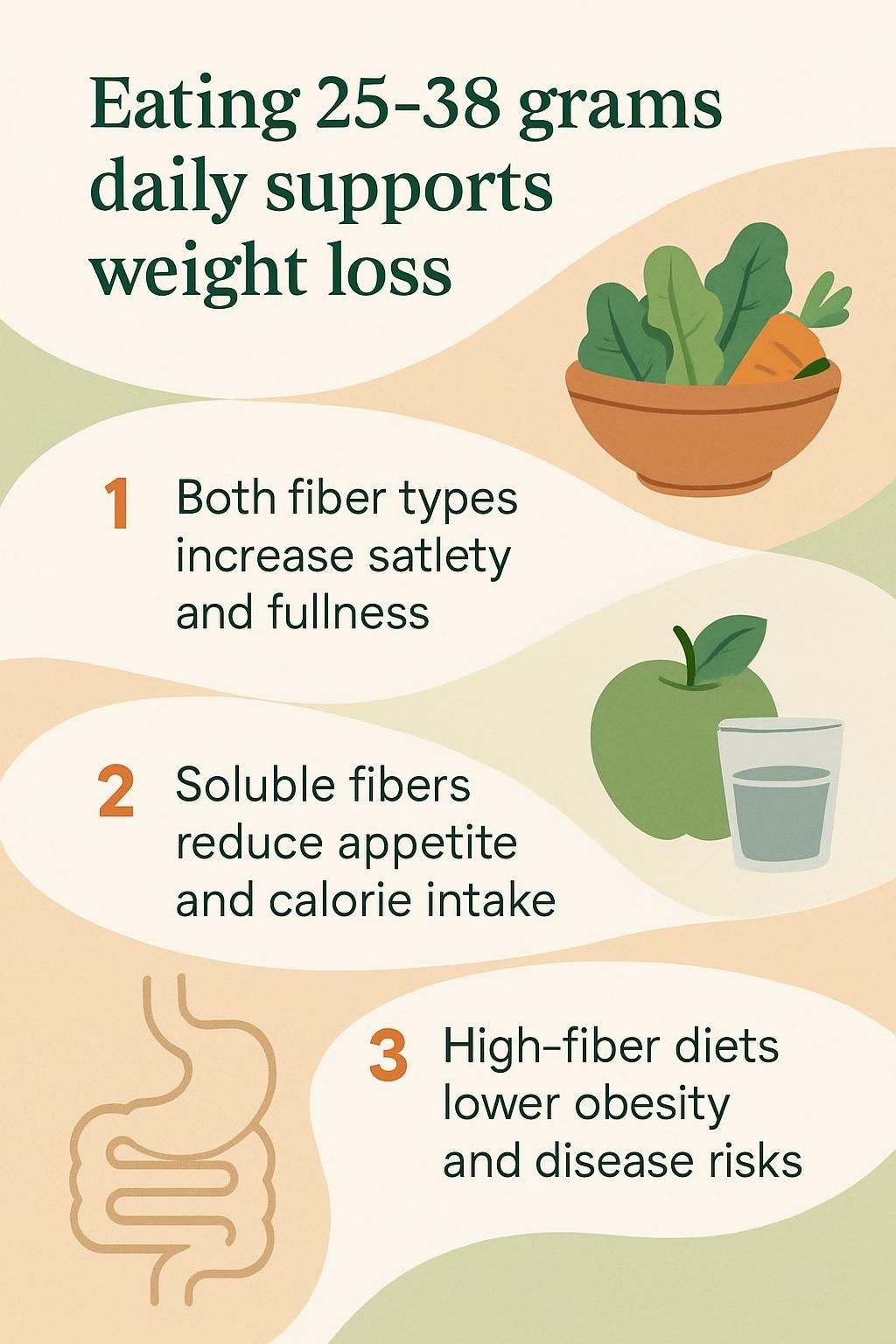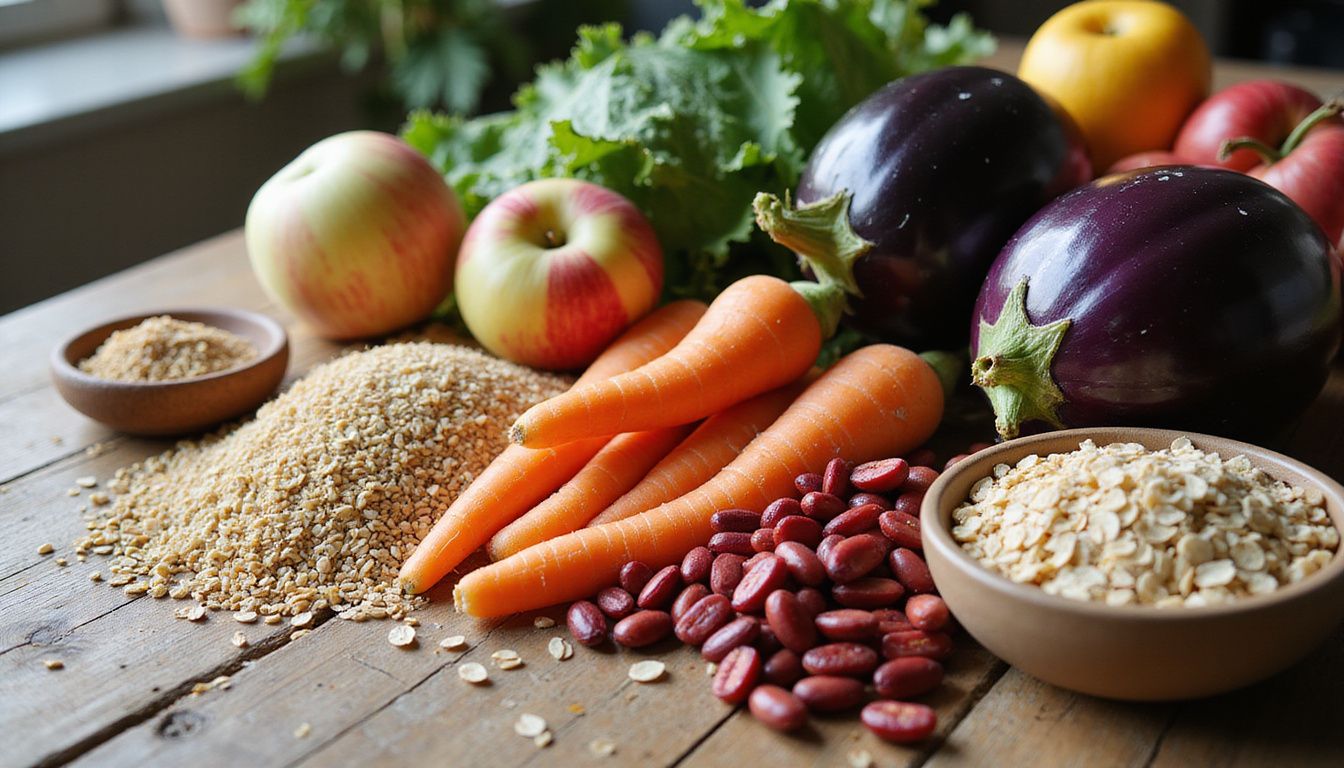Fiber For Weight Loss: How Dietary Fiber-Rich Foods Help With Your Diet
Our Nutrition Assistant AI Suite will transform your body. You will lose fat, get toned, and build muscle. Gain confidence and optimal health.
If you struggle to lose weight or feel hungry between meals, you are not alone. Research suggests that eating about 30 grams of dietary fiber per day supports weight loss, steadier blood sugar, and lower blood pressure. Building meals around fiber-rich foods can help you control appetite and stick with your plan.
This guide explains how fiber for weight loss works. You will learn what fiber is, where to find it, and how getting more fiber helps reduce hunger and supports your goals.
Simple changes can make a real difference in your health and energy.
Key Takeaways
- Most adults benefit from 25 to 38 grams of dietary fiber per day. This range supports weight management, blood sugar control, and heart health.
- Soluble and insoluble fibers from fruits, vegetables, legumes, and whole grains increase fullness and slow digestion, which can lower total calorie intake.
- Viscous soluble fibers such as beta-glucans and psyllium form gels in the gut, which delay stomach emptying and reduce appetite.
- Higher fiber intake is linked with lower LDL cholesterol and lower risks of obesity, type 2 diabetes, stroke, and other chronic diseases.
- Fiber supplements can help you close the gap if food alone falls short, but they work best with a balanced, whole-food diet.

What is Dietary Fiber?

Dietary fiber is a type of carbohydrate found in plant foods. Your body cannot fully digest it. You get fiber from fruits, vegetables, whole grains, legumes, nuts, and seeds. Eating more of these foods strengthens your nutrition and helps with weight control.
What are the types of dietary fiber?
There are two main types, and each helps your health in different ways. Some fibers are also prebiotics, meaning they feed your good gut bacteria.
- Soluble fiber dissolves in water and forms a gel that slows digestion. Good sources include oats, apples, citrus, beans, and psyllium. This type helps lower cholesterol and steady blood sugar.
- Insoluble fiber does not dissolve in water. It adds bulk to stool and supports regularity. Wheat bran, whole grains, vegetables, and nuts are rich in insoluble fiber.
- Viscous fiber is a subgroup of soluble fiber known for reducing appetite. Examples include beta-glucans from oats and barley, pectins from apples, glucomannan, guar gum, and psyllium.
- Prebiotic fibers such as resistant starch feed beneficial gut bacteria. They are found in beans and some whole grains. During fermentation, they produce short-chain fatty acids that support gut and metabolic health.
- Both soluble and insoluble fibers can support weight loss by increasing fullness, improving gut balance, and helping reduce body weight.
- Many foods contain a mix of both types. Eating a variety helps you reach the 25 to 38 grams recommended for adults.
- Boost intake with fruits and vegetables, legumes like lentils or black beans, whole grains such as oatmeal, plus chia seeds, flaxseeds, and some dried fruits.
Building meals around these foods can help you lose weight and support heart, gut, and metabolic health.
Why is fiber important in a balanced diet?
Fiber supports your digestive system by adding bulk to stool and promoting regular bowel movements. High fiber meals take longer to digest than processed foods, which helps control body weight. The American Heart Association links higher fiber intake with lower cholesterol and reduced risk of stroke, type 2 diabetes, and cardiovascular disease.
Experts such as Dr. Frank Hu encourage getting most of your fiber from whole food sources like vegetables, fruits, beans, cereals, nuts, and seeds. People who consume at least 25 to 30 grams a day often show lower levels of inflammation. This pattern supports better metabolic health and may lower the risk of chronic conditions.
“Fiber-rich diets support digestive health and play a key role in preventing major diseases,” says Dr. Frank Hu.
Higher fiber intake is also tied to better quality of life in large data reviews from the Centers for Disease Control and Prevention.
How Fiber Supports Weight Loss
Fiber and weight loss are closely linked. Fiber can help you manage hunger, steady blood sugar, and reduce total calories without feeling deprived.
How does fiber increase satiety and reduce hunger?
Fiber adds volume to meals without adding many calories. It swells with water in your stomach and triggers stretch receptors that tell your brain that you are full. You feel satisfied sooner and stay full longer.
Viscous fibers found in oats, beans, apples, and barley form gels that delay stomach emptying. Studies show that people who eat 25 grams or more of fiber per day report less hunger between meals than those on low fiber diets.
Try simple swaps. Add lentils or chia seeds, both rich in fiber, to lunch. Many people find they snack less in the afternoon.
How does fiber slow digestion to keep you full longer?
Soluble fiber mixes with water to create a thick gel. This gel slows how fast food leaves your stomach and moves into your small intestine. Foods like oats, beans, and apples are rich in this type of fiber.
Slower digestion means you stay full longer and avoid quick spikes in blood sugar. A classic review found that raising daily fiber by 14 grams was associated with an average four pound weight reduction over about four months. Building fiber slowly helps many people feel satisfied after meals with less bloating.
Can fiber reduce fat absorption during digestion?
Soluble fiber can bind some dietary fat in the gut. This gel-like mix limits how much fat gets absorbed into the bloodstream. The rest leaves the body in stool. This is one reason foods high in soluble fiber support cardiometabolic health.
Eating fiber-rich foods like oats, beans, lentils, apples, and nuts with meals can reduce total fat absorption. Hitting 25 to 30 grams of fiber per day from whole foods, especially soluble sources, may support healthier body weight and metabolism over time.
How does fiber stabilize blood sugar levels?
Soluble fiber slows sugar absorption from your intestine into the bloodstream. Oats and beans form gels that steady post-meal blood sugar levels and reduce dips that can trigger cravings. This helps you avoid energy crashes.
Studies show higher fiber intake improves insulin response in people with diabetes. Choosing whole grain toast instead of white bread at breakfast is a simple example. Many people report fewer mid-morning cravings and steadier energy.
The Role of Fiber in Gut Health
Think of fiber as daily fuel for your gut community. A well-fed microbiome supports better digestion and whole-body health.
How does fiber feed beneficial gut bacteria?
Prebiotic fibers, including resistant starch and many soluble fibers, pass through your upper digestive tract intact. In the colon, friendly bacteria such as Bifidobacteria and Lactobacilli ferment these fibers. This process creates short-chain fatty acids, which nourish the gut lining and support healthy metabolism.
Western-style diets often lack these fibers, which may harm the balance of gut bacteria. Eating more fiber-rich foods supports regularity, a healthier microbiome, and is linked with lower body weight and reduced risk of conditions such as hypertension and high cholesterol.
Can fiber reduce inflammation and cravings?
Higher fiber intake is linked with lower levels of inflammatory markers in blood tests. When gut bacteria ferment fiber, they produce short-chain fatty acids that help calm inflammation in the intestines. Over time, this may lower the risk of chronic inflammatory diseases.
Fiber also helps control cravings. Slower digestion leads to steadier blood sugar, fewer hunger spikes, and better appetite control. Many people notice reduced urges for sugary snacks as their daily fiber increases.
How does fiber support metabolic health?
Fiber moderates the absorption of sugars, which supports steady energy and helps prevent hyperglycemia, the medical term for high blood sugar. Eating more fiber-rich foods also slows eating pace and may improve insulin sensitivity. That means your body can use glucose more efficiently.
Research from lifestyle programs that emphasize fiber shows improved confidence with weight management and better self-rated health. Fermentation of certain fibers can influence appetite hormones and fat metabolism. People often report fewer cravings and more stable moods after higher fiber meals.
Specific Types of Fiber for Weight Loss
Different fibers act like different tools. Soluble, viscous, and insoluble fibers each bring unique benefits for appetite, digestion, and weight control.
What are the benefits of soluble fiber?
Soluble fiber dissolves in water and forms gels, which slow digestion and increase fullness. It can bind some fats in the gut and help lower LDL cholesterol. Higher intakes are linked with better weight control and reduced chronic disease risk.
Good sources include oats, beans, apples, lentils, and many whole grains. As you increase soluble fiber, you may find cravings fade and your energy levels feel steadier through the day.
How does viscous fiber help reduce appetite?
Viscous fibers like pectins, beta-glucans, psyllium, glucomannan, and guar gum thicken when mixed with water. This thicker gel delays stomach emptying and boosts fullness after meals. People who eat more viscous fiber, such as beans, legumes, Brussels sprouts, flaxseeds, and oats, often report a lower appetite during the day.
Because digestion slows, hunger signals arrive later. Including viscous fiber regularly can make meals more satisfying without adding many calories. Researchers, including Professor Jim Mann, have highlighted these satiety effects in nutrition studies.
Why is insoluble fiber important for digestive health?
Insoluble fiber adds bulk and helps keep things moving. You find it in whole grains, nuts, and vegetables. Since your body does not digest it, it supports regular bowel movements and helps prevent constipation.
Certain forms, such as some resistant starches, also behave like prebiotics and support gut bacteria. People who add more whole grains and nuts to meals often notice improved regularity and digestive comfort within days.
Best Dietary Sources of Fiber
You can reach your fiber goals with foods from many cultures and cuisines. Mix and match to get both types of fiber plus key vitamins and minerals.
Which fruits and vegetables are high in fiber?
Whole, minimally processed produce gives you the best fiber and nutrient mix. Here are common options with useful amounts.
- Pears have about 6 grams of fiber per medium fruit with skin.
- Apples offer around 4 grams per medium fruit with skin. An easy snack for steady energy.
- Bananas provide about 3 grams per medium banana. Add to cereal or smoothies.
- Spinach gives about 4 grams per cooked cup. Tuck into salads, eggs, or pasta.
- Broccoli supplies roughly 3 grams per half-cup plus vitamin C.
- Brussels sprouts provide about 2 grams per half-cup serving.
- Carrots offer around 2 grams per medium carrot, raw or cooked.
- Green beans deliver about 2 grams per half-cup serving.
- Dried prunes are rich in both fiber types; six prunes contain about 12 grams.
- Raisins contribute about 2 grams per half-cup.
Choosing these foods boosts fullness and slows digestion, which helps with weight management while supporting overall nutrition.
What whole grains provide the most fiber?
Whole grains add satisfying texture, steady energy, and a mix of soluble and insoluble fiber. Rotate several during the week for variety.
- Oatmeal, cooked, 1 cup, 4 g. A steady source of soluble fiber that supports healthy blood sugar.
- Barley, cooked, 1 cup, 9 g. High in beta-glucans that lower cholesterol and increase satiety.
- Brown rice, cooked, 1 cup, 4 g. Keeps the fiber-rich bran layer that white rice lacks.
- Whole-wheat bread, 1 slice, 3 g. A simple way to add fiber at any meal.
- Shredded Wheat cereal, 1 cup, 6 g. Offers both fiber types for digestive health.
- Fiber One cereal, 1 cup, 14 g. Very high fiber for those who need a bigger boost.
- All-Bran cereal, 1 cup, 10 g. Rich in insoluble fiber to support regularity.
Pair whole grains with legumes or nuts to increase fiber and protein in the same meal.
Which legumes are rich in dietary fiber?
Legumes are fiber powerhouses that also provide plant protein and minerals. They help you feel full and support steady energy.
- Kidney beans, 6 grams per cooked half-cup. Great in salads, soups, or chili.
- Lima beans, 6 grams per cooked half-cup. Creamy texture, easy side dish.
- Baked beans, 5 grams per half-cup from canned sources. Savory and convenient.
- Chickpeas, high in fiber and prebiotic value. Use in salads, stews, or hummus.
- Black beans, about 7 to 8 grams per cooked cup. Support blood sugar control.
- Lentils, about 8 grams per cooked half-cup. Quick cooking and versatile.
- Green peas, 4 to 5 grams per cooked half-cup. Add to grain bowls or soups.
Combining legumes with whole grains creates complete meals that manage hunger and support weight loss efforts.
What nuts and seeds are good fiber sources?
Nuts and seeds add fiber, healthy fats, and crunch. A small portion goes a long way in meals and snacks.
- Peanuts, about 1 gram per 10 nuts. Sprinkle on salads or enjoy as a snack.
- Popcorn, about 1 gram per cup. A light, high-volume snack.
- Pumpkin seeds offer fiber and key minerals. Add to soups or grain bowls.
- Sunflower seeds provide fiber and healthy fats. Stir into yogurt or oatmeal.
- Almonds contain both fiber types. A small handful can increase satiety.
- Walnuts add fiber plus omega-3 fats. Helpful for heart and brain health.
- Chia seeds absorb water and form a gel that supports fullness. Use in smoothies or puddings.
- Flaxseeds offer fiber that supports gut bacteria. Grind and add to oatmeal or muffins.
Rotate several nuts and seeds to keep calories in check while hitting your daily fiber goal.
Fiber Supplements for Weight Loss
Food first is the best plan. If you still fall short, the right supplement can help you reach your target.
What types of fiber supplements are available?
Supplements contain either isolated fibers or blends. Choose products with evidence and simple ingredient lists.
- Psyllium husk supplies soluble, viscous fiber. Available as powders, capsules, or wafers.
- Guar gum is an isolated fiber that mixes well with liquids. It may help with appetite control.
- Glucomannan comes from konjac root. Several trials suggest it can increase satiety when taken before meals.
- Wheat dextrin and inulin are tasteless powders, easy to add to drinks or foods.
- Methylcellulose dissolves clearly in water and does not thicken beverages.
- Fiber gummies or chewables offer convenience. Many use chicory root or polydextrose.
- Bars and snacks with added fiber can fill gaps on busy days. Check labels for sugar and calories.
When should you consider taking fiber supplements?
Consider a supplement if your schedule or dietary limits keep you under 25 to 38 grams per day. Some people with constipation or irritable bowel symptoms may also benefit, with guidance from a clinician.
Supplements alone rarely drive major weight loss. The best outcomes come from combining them with fiber-rich meals, smart portions, and regular activity. Increase intake gradually and drink plenty of water.
What are tips for using fiber supplements effectively?
Use a stepwise approach to avoid discomfort and get the most from your supplement.
- Start low, about 3 to 5 grams per day. Give your gut time to adjust.
- Increase slowly every few days. Aim for 25 grams daily for women and 38 grams for men.
- Drink at least eight cups of water per day to prevent cramps, bloating, or diarrhea.
- Take fiber with meals, not on an empty stomach, to reduce upset.
- Choose evidence-backed options such as psyllium or methylcellulose for appetite support.
- Read labels and watch for added sugars or sweeteners that raise calories.
- Monitor symptoms. If issues last more than a week, contact a registered dietitian or healthcare provider.
How to Incorporate More Fiber Into Your Diet
Small steps add up. Build fiber into each meal and allow your digestive system time to adapt.
How can you gradually increase fiber intake?
Increase fiber slowly to limit gas and bloating. These steps help you reach your goal without discomfort.
- Start breakfast with oatmeal or whole grain toast. A strong start sets the tone for the day.
- Add one extra serving of fruits or vegetables daily. Aim for variety and color.
- Choose whole grains like brown rice, quinoa, or whole wheat pasta instead of refined grains.
- Snack on high fiber options such as nuts, seeds, fresh fruit, or carrot sticks.
- Drink more water as you add fiber. This helps stool move smoothly.
- Check labels and pick foods with at least 3 grams of fiber per serving.
- Increase portions gradually over a few weeks to reduce cramps and gas.
- Track intake with a food diary or app. Aim for your recommended range each day.
- Combine fiber with protein at meals to stabilize hunger.
- Trade one low fiber snack for a piece of fruit. Many people notice longer lasting fullness right away.
Why combine fiber-rich foods with protein?
Pairing fiber with protein increases fullness and slows digestion. It also smooths blood sugar rises after meals. For example, beans with chicken or lentil soup with a side of Greek yogurt can keep you satisfied longer than either nutrient alone.
This combo supports better appetite control and makes it easier to stick with your plan across the day.
How does staying hydrated improve digestion?
Water helps fiber do its job. As you raise fiber intake, increase water so stool remains soft and easy to pass. This reduces bloating and discomfort.
Many people feel better digestion and steadier energy when they drink water with each high fiber meal or snack.
Common Myths About Fiber and Weight Loss
Clearing up myths helps you focus on what works and ignore what does not.
Is fiber alone enough for weight loss?
No single nutrient can do it all. Fiber supports satiety and blood sugar control, which helps you eat fewer calories. The best results appear when fiber-rich meals are paired with a balanced calorie target and regular activity. Use fiber to make your plan easier to follow.
Are high-fiber foods always low in calories?
Some high fiber foods are calorie dense. Nuts, seeds, and avocados are rich in fiber and healthy fats, so portions matter. Other fiber sources such as leafy greens, berries, and broccoli are lower in calories. Measure grains and nuts, and load up on vegetables to balance your plate.
Does fiber cause digestive issues?
Digestive issues are common only when fiber rises too quickly. Gas, cramps, and bloating often ease once your gut adapts. Increase intake slowly and drink more water. Most people adjust within one to two weeks.
Recommended Daily Fiber Intake
Targets vary by age and sex. Aim for the recommended range, then tailor your food choices to hit your number most days.
What are the fiber intake guidelines for adults and children?
These daily goals support digestive health, weight control, and heart health.
| Age Group | Recommended Daily Fiber Intake | Notes / Key Facts |
|---|---|---|
| Children (1–3 years) | 19 grams | Introduce slowly to prevent discomfort |
| Children (4–8 years) | 25 grams | Focus on fruits, vegetables, and whole grains |
| Boys (9–13 years) | 31 grams | Encourage variety in fiber sources |
| Girls (9–13 years) | 26 grams | Include both soluble and insoluble fibers |
| Boys (14–18 years) | 38 grams | Ensure adequate hydration |
| Girls (14–18 years) | 26 grams | Balance fiber with lean proteins |
| Men (19–50 years) | 38 grams | Some programs suggest aiming for 40 grams |
| Women (19–50 years) | 25 grams | Choose a variety of fiber-rich foods |
| Men (51 years and older) | 30 grams | May reduce metabolic syndrome risk |
| Women (51 years and older) | 21 grams | Supports continued digestive health |
- People with metabolic syndrome often average only about 19 grams per day, which is below recommendations.
- Most adults should aim for 25 to 30 grams daily. Some organizations promote a 40 gram goal for added benefit.
- Meeting fiber targets supports weight loss, better blood sugar control, and improved gut health.
How can you meet your daily fiber goals?
Plan fiber at every meal and snack. These steps help you reach your target without guesswork.
- Eat fruit at breakfast or as snacks. Add an extra serving to raise daily intake.
- Include vegetables at lunch and dinner. Aim for another serving each day.
- Stir beans into salads, soups, or bowls to increase fiber and protein.
- Pick whole grains such as oats, brown rice, or quinoa instead of refined grains.
- Snack on nuts or seeds in small portions to add fiber between meals.
- Spread fiber across the day instead of loading it all at once.
- Track progress with a food diary or app to stay within your range.
- Increase fiber gradually to reduce gas or cramps as your gut adapts.
- Drink water with every high fiber meal or snack to help digestion.
- Pair fiber with protein to boost satiety and support a steady eating pattern.
Other Health Benefits of Dietary Fiber
Fiber supports more than weight loss. It helps your heart, blood sugar, and cholesterol levels, which adds up to better long-term health.
How does fiber improve heart health?
Soluble fiber binds some cholesterol in the digestive tract and carries it out of the body. This lowers LDL cholesterol and can reduce plaque buildup in arteries. Oats and beans are proven sources of this effect.
Research links higher fiber intake with better cardiometabolic markers in people with obesity. Many people also see improvements in blood pressure and lipid levels after increasing fiber-rich foods.
Can fiber lower the risk of type 2 diabetes?
High fiber eating patterns that feature fruits, vegetables, and whole grains can help prevent type 2 diabetes. Fiber slows how quickly sugars enter your bloodstream, which steadies blood sugar after meals.
In one study, adults at risk for diabetes lost weight on a high carbohydrate, high fiber, low fat diet. Adding beans and oats several times a week is a practical place to start.
How does fiber help manage cholesterol?
Soluble fiber attaches to cholesterol and bile acids in your gut. This reduces absorption and prompts your body to use cholesterol to make more bile. Eating 5 to 10 grams of soluble fiber per day can lower LDL cholesterol by roughly 5 to 11 percent.
Regular choices like a morning bowl of oatmeal or a daily serving of beans can show benefits within weeks.
Conclusion
Getting more dietary fiber is one of the simplest ways to support weight loss. Fiber-rich foods help you feel full, steady blood sugar, and reduce cravings. Aim for 25 to 30 grams each day from fruits and vegetables, whole grains, legumes, nuts, and seeds. If needed, consider fiber supplements as a backup to food.
Small swaps add up. Build each meal around plants, drink enough water, and increase fiber gradually. These steps can help you lose weight and feel better, day after day.
This article is for education, not medical advice. If you have a health condition or take medication, talk with your healthcare provider before making major diet changes.
FAQs
1. How does dietary fiber help with weight loss?
Dietary fiber increases fullness after eating, which can reduce overall calorie intake. Studies show that people who eat more high-fiber foods often weigh less than those who do not. Fiber-rich foods also slow digestion, helping control blood sugar and hunger.
2. What are some examples of fiber-rich foods for a diet?
Whole grains like oats and brown rice, legumes such as lentils and chickpeas, fruits including apples and pears, and vegetables like broccoli provide significant amounts of dietary fiber per serving.
3. Can increasing dietary fiber improve other aspects of health during weight loss?
Research indicates that higher intake of dietary fiber supports healthy cholesterol levels and better digestive function while dieting. A 2020 review found adults consuming at least 25 grams daily had lower risks for heart disease compared to those with low intake (Anderson et al., 2020).
4. Is it easy to add more dietary fiber to my meals each day?
Adding beans or whole grain bread to lunch or choosing fruit instead of dessert can raise your daily intake without major changes in routine. In my experience, swapping white rice for quinoa made me feel fuller longer; this small change helped me avoid snacking between meals.
Summary: Dietary fiber helps manage appetite by promoting satiety; it is present in many plant-based foods such as grains, legumes, fruits, and vegetables; increased consumption benefits both weight management and heart health; simple meal adjustments make it easier to meet recommended daily amounts.







